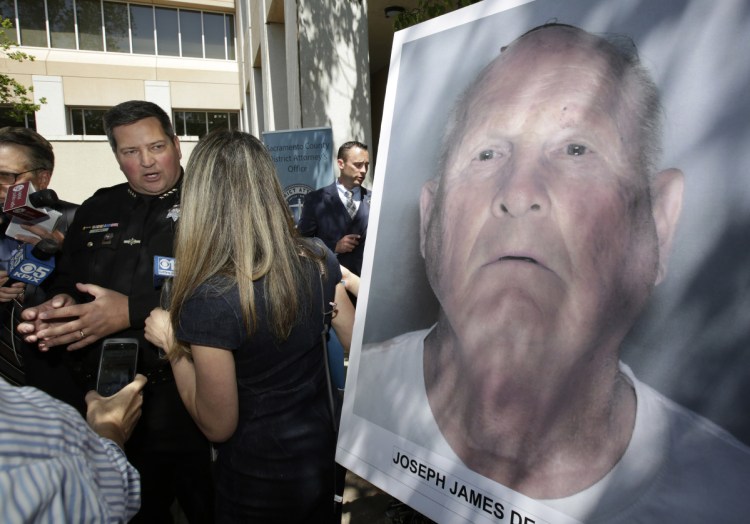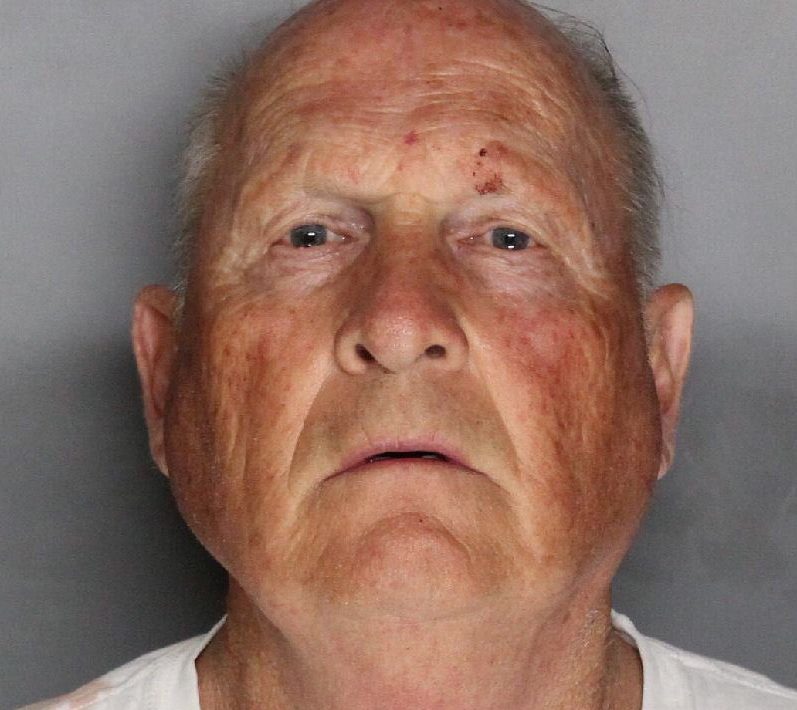If Joseph James DeAngelo Jr. is the Golden State Killer, as police allege, then he spent his 30s in a nearly nonstop frenzy of sadistic violence – breaking into a house every few weeks in the late 1970s, raping dozens of women, and escalating to serial killings before the crime spree suddenly ended in 1986.
And if DeAngelo is the killer – police say his DNA proves that he is – then he fit these 45 suspected rapes and 12 suspected murders into an astonishing double life. He was a Vietnam veteran before the spree, a police officer during the spree, and then a husband, father and grandfather who lived quietly among the same communities that the Golden State Killer had terrorized.
DeAngelo lived like that – apparently free of suspicion – until Tuesday, when a break in the case led FBI agents and police to arrest the 72-year-old in the Sacramento, California, suburb where he raised a family.
Reporters have now begun to piece together the puzzle of DeAngelo’s life – how he wore a police uniform by day while the Golden State Killer stalked at night, and raised children in the wake of those crimes, and blended into northern California suburbia for decades, appearing to his neighbors as little more than a slightly eccentric old man with a temper.
Here is what we know about DeAngelo’s life.
• DeAngelo was a police officer when the killer’s rape spree began.
“James DeAngelo Jr. believes that without law and order there can be no government and without a democratic government there can be no freedom,” reads a 1973 article in the Exeter Sun, announcing that the 27-year-old Navy veteran had recently joined Exeter’s police force.
The Foothills Sun-Gazette republished the article this week, complete with a photo of a young DeAngelo – clean-shaven and light-haired, like the man who would appear in police sketches once the Golden State Killer began his spree three years later.
The new officer’s bona fides looked good when he came to Exeter, which sits in central California, midway between Sacramento and Los Angeles. DeAngelo had lived in the state since his late teens, according to the Sacramento Bee – raised by a Denny’s waitress and a welder. The Associated Press reported that he had served as a repairman on the USS Canberra in the late 1960s during the Vietnam War. He lost a finger before leaving the military, one of his neighbors told the Bee.
DeAngelo joined the Exeter police force in May 1973, with a California State University a degree in criminal justice, the newspapers reported.
That fall, the rookie officer married Sharon Marie Huddle, the Bee reported. Exeter’s current police chief said he has been unable to find any records of DeAngelo’s employment, but the Associated Press reports that he served in the town until 1976 – when he took a job with the Auburn Police Department outside Sacramento.
It was in those same Sacramento suburbs, that same summer, that the Golden State Killer started to rape women in their homes.
• DeAngelo was fired from the police force before the killer’s spree ended.
By 1979, people in Sacramento County, California, lived in dread of the man they called the East Area Rapist. Among his nearly four dozen victims over the previous three years were a 13-year-old girl; women assaulted while their husbands were tied up in the same house; women who lived just blocks from one another, as the rapist terrorized entire neighborhoods week after week.
The man was as meticulous as he was violent, Los Angeles Magazine wrote in a profile, often casing houses before his assaults – studying floor layouts, disabling locks and lights and hiding weapons. In the rare cases when he was caught in the act, he could jump roofs and vault fences to escape.
As police in surrounding suburbs searched fruitlessly for a break in the case, DeAngelo was still an officer in Auburn, according to the AP. He was photographed at the annual “Fuzz Ball” in June 1979, in cap and uniform, posing with a baseball bat.
A few months later, the AP wrote, “the department fired him after he was caught shoplifting a hammer and dog repellent.”
So 1979 marked the end of DeAngelo’s life as a police officer.
The rapist ended his spree around Sacramento the same year, according to Los Angeles Magazine. He relocated to Southern California, where people would call him the Original Night Stalker and eventually the Golden State Killer – because he stopped leaving his victims alive.
• He became a grandfather.
It’s unclear where DeAngelo lived between the winter of 1979 and the summer of 1981, during which period the Golden State Killer is believed to have committed most of his 12 suspected homicides – still raping women, but now also shooting or beating them to death before he left the house, and often killing their boyfriends or husbands as well.
The final killing took place after a five-year hiatus, in 1986, when an 18-year-old woman was raped and bludgeoned in Irvine, near Los Angeles, and the Golden State Killer disappeared without a trace.
By then, the Bee reported, DeAngelo had been living for three years in a ranch-style house in Citrus Heights, outside Sacramento.
He would spend most of the rest of his life there – among the same communities that the East Area Rapist had terrorized.
DeAngelo took a job at a nearby Save Mart distribution center in the early 1990s, the AP reported, and worked there for 27 years before retiring last year, in his 70s.
Retirement “was something he’d been looking forward to for a long time,” neighbors in Citrus Heights told the Bee. “He planned to do a lot of fishing. … He was also an avid bike rider.”
His wife does not appear to have stayed with him. A neighbor told the Bee that they were divorced, while a KCRA News reporter, citing law enforcement, said the couple remained “technically married, though estranged.”
DeAngelo had multiple children, according to authorities. His next-door neighbor told the Bee that a daughter and granddaughter had been living with him recently – until his arrest this week.
• He had a nice lawn – and a bad temper
“You can tell he’s a very meticulous person,” one Citrus Heights neighbor, Kevin Tapia, said after DeAngelo’s arrest. “His house is always perfectly painted. His grass is always cut. He gets down around all the rocks on his lawn and is cutting to make sure it’s just perfect.”
Precision was important to DeAngelo, Tapia told the Bee – “to the point of having permanent markings on his driveway so he could be exact in parking his boat.”
In contrast to his tidy home, several neighbors said, DeAngelo himself was prone to fits of rage and occasionally disturbing intrusions into their lives.
“This guy just had this anger that was just pouring out of him,” Grant Gorman, who grew up in the house behind DeAngelo’s, told the Bee. “He’d just be yelling at nothing in the backyard, pacing in circles.”
These rages went back decades, Gorman said – to 1994, when DeAngelo left a voice mail threatening to “deliver a load of death” if the family’s dog didn’t stop barking.
Another neighbor, Eddy Verdon, told The Washington Post that three years ago he heard someone on his property, and opened his garage door to find DeAngelo mounting a bicycle to flee.
“I stared him down, and he looked at me nervously,” Verdon said. “I never really interacted with him again. Maybe it wasn’t such a bad idea.”
“We used to just call him ‘Freak,’ ” Natalia Bedes-Correnti told the Bee. “He used to have these temper tantrums … usually because he couldn’t find his keys.”
But the portly grandfather had calmed down in the past few years, she said. He was even well liked by some neighbors.
Cory Harvey, who lived next door, told the Bee that DeAngelo helped pay to put a fence between their houses, and would always apologize when she overheard him cursing.
• His arrest was a surprise.
Even those neighbors most wary of DeAngelo were stunned by what police now alleged: that he was the monster who terrorized California in the 1970s and 1980s.
DeAngelo did not seem to expect the police either. A former Sacramento County Sheriff’s Office detective, who investigated some of the first rapes in the case, told The Post that he was never a suspect in those years.
DeAngelo had been working in his garage on Tuesday afternoon, the Bee reported – building a table, according to one neighbor. Unknown to him, an as-yet-unexplained break in the case had caused police to put him under surveillance, and secretly acquire a DNA sample they said matched to the rapes and killings.
One neighbor saw several cars pull up to DeAngelo’s house in the late afternoon, and armored police pour out of them, with arrest warrants on charges of murder.
DeAngelo, surprised, surrendered without incident, the AP wrote.
He reportedly told deputies he had a roast in the oven.
Sawsan Morrar and The Washington Post’s Justin Jouvenal contributed to this report from California.
Send questions/comments to the editors.




Comments are no longer available on this story